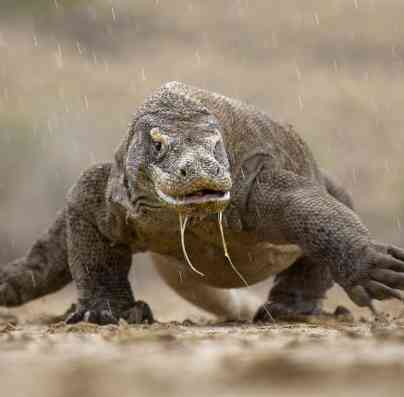(Factual and Critical Report text)
The Komodo dragon (Varanus komodoensis) is a captivating reptile native to the Indonesian islands of Komodo, Rinca, Flores, Gili Motang, and Padar. Renowned as the largest living lizard species on Earth, the Komodo dragon holds a unique place in the animal kingdom. However, this remarkable creature faces numerous challenges, including habitat loss and human activities that threaten its existence. This report aims to shed light on the factual aspects of the Komodo dragon's life, its habitat, and the conservation efforts being made to protect this endangered species.
Komodo dragons are impressive reptiles, reaching lengths of up to 10 feet (3 meters) and weighing around 150 pounds (70 kilograms) on average. They have a sturdy build, muscular limbs, and a long tail. Their scaly skin provides protection, often displaying colors ranging from gray to greenish-brown, which helps them blend into their natural environment. These reptiles possess a strong jaw filled with sharp teeth and a venomous bite, making them formidable predators.
Komodo dragons primarily inhabit the arid grasslands, savannas, and forests of the Indonesian islands they call home. These reptiles are solitary animals, with males maintaining territories that encompass the females' ranges. They are excellent swimmers and have been observed crossing stretches of water between islands.
As apex predators, Komodo dragons possess a keen sense of smell and are opportunistic hunters. Their diet mainly consists of carrion, though they also prey on birds, mammals, and other reptiles. Their saliva contains a variety of bacteria, which can cause infections in their prey. Additionally, Komodo dragons have been observed engaging in cannibalism, preying on smaller individuals, including their own young.
Efforts are underway to protect the Komodo dragon and its habitat. The Indonesian government has established Komodo National Park, a UNESCO World Heritage site, which provides a protected area for these reptiles. The park, spanning several islands, aims to preserve the Komodo dragon's natural habitat and promote its conservation. Conservation organizations and local communities also play a crucial role in safeguarding the species. They focus on raising awareness, conducting research, and implementing measures to combat habitat degradation and poaching. Captive breeding programs have been initiated to maintain genetic diversity and potentially reintroduce Komodo dragons to areas where their populations have dwindled.
The Komodo dragon represents an iconic and awe-inspiring creature that has captured the imagination of people worldwide. However, its survival is at risk due to habitat loss, poaching, and other human-induced factors. It is essential for governments, conservation organizations, and individuals to collaborate in protecting this magnificent species and its fragile ecosystem. By raising awareness, supporting conservation initiatives, and promoting sustainable practices, we can contribute to the preservation of the Komodo dragon and ensure its existence for generations to come.
Follow Instagram @kompasianacom juga Tiktok @kompasiana biar nggak ketinggalan event seru komunitas dan tips dapat cuan dari Kompasiana
Baca juga cerita inspiratif langsung dari smartphone kamu dengan bergabung di WhatsApp Channel Kompasiana di SINI







